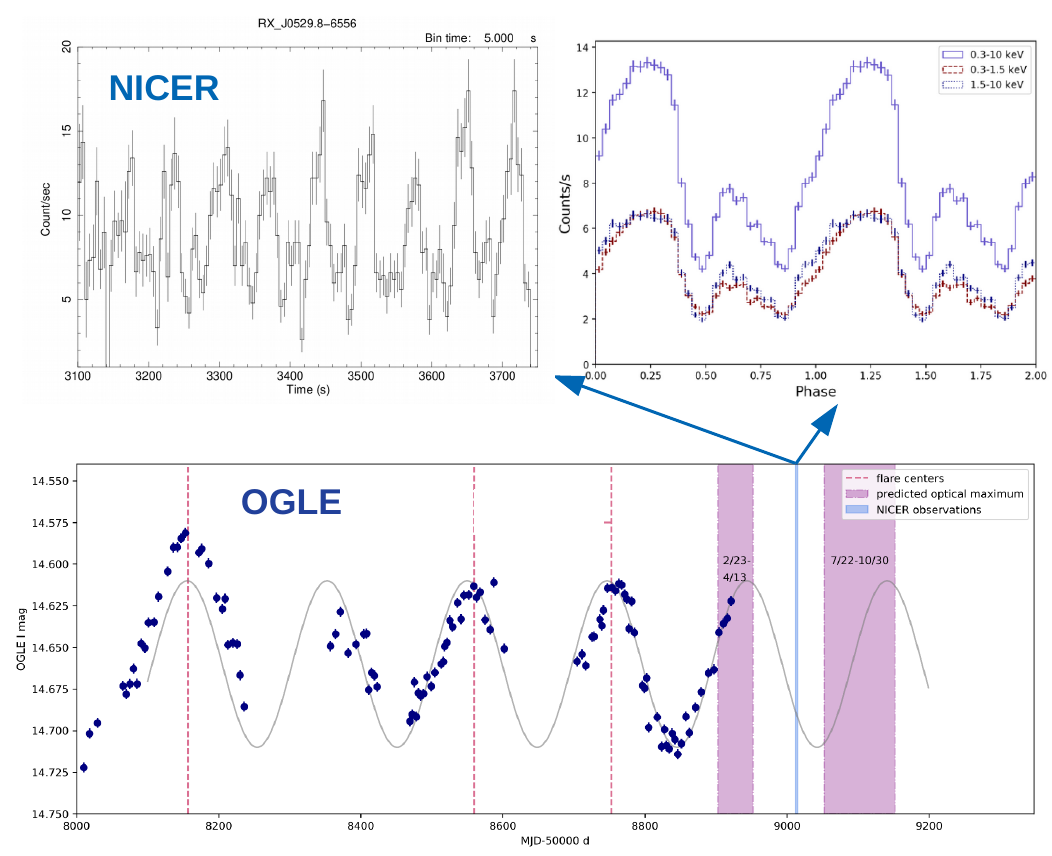NICER / ISS Science Nugget
for June 25, 2020
eROSITA points NICER to a rare X-ray binary outburst in the Large Magellanic Cloud
X-ray observatories come in all shapes and sizes, with different characteristics and capabilities. The eROSITA
instrument on-board the Russian/German Spektrum-Roentgen-Gamma (SRG) mission is conducting an all-sky survey to
provide a new, sharp view of hot and energetic processes across the universe. During its scans, it encounters
transient events that would otherwise go unnoticed. RX J0529.8-6556 is an X-ray binary (XRB) anchored by a Be-type
star located in the Large Magellanic Cloud (LMC), one of the nearest star-forming galaxies to our Milky Way. The
massive Be star feeds material to its young neutron-star companion every time they approach one another in their
eccentric orbit.
RX J0529.8-6556 was initially discovered in the 1990s as a weak X-ray source and has received little
attention; between 2020 June 6 and June 23 eROSITA scanned the LMC and discovered that RX J0529.8-6556 was 100x brighter
than the last detection of the system in the year 2000, as reported in Astronomer's Telegram (ATel) #13828. NICER
followed up within 24 hours. Led by G. Vasilopoulos (Yale U.), researchers then identified regular pulsations from
the system and studied their shape as well as the neutron star's spin evolution, published this week in ATel
#13830.
BeXRBs like RX J0529.8-6556 are known to show modulation in their optical and X-ray lightcurves related to the binary
orbital period. Since outbursts occur at or near the periastron passage of the neutron star, more often than not
the peak of the X-ray and optical outbursts coincide in time. RX J0529.8-6556 shows variability in its optical
lightcurve that suggests an orbital period of 150-200 days. The current X-ray outburst, however, happened during
the predicted optical minimum, puzzling researchers (see figure). The combination of eROSITA and NICER
capabilities together with optical monitoring of the LMC – by the Optical and Gravitational Lensing Experiment
(OGLE) – will help unravel the mysteries of this intriguing system.

Figure:
The lower panel shows the optical lightcurve (OGLE data) of RX J0529: a sinusoidal modulation with 198-day period
is plotted to guide the eye. Predicted optical outbursts are marked with shaded regions. The location of the X-ray
outburst observed by eROSITA and followed up by NICER is marked with a blue vertical line. X-ray pulsations are
visible by eye in the NICER lightcurve (upper left panel). NICER observations allowed the detection of pulsations
with a period of 68.68 s, and the study of the pulse profile with unprecedented detail. Credit: G. Vasilopoulos
(Yale U.) and H. Treiber (Yale U., Amherst).
<< Previous
Main Index
Next >>